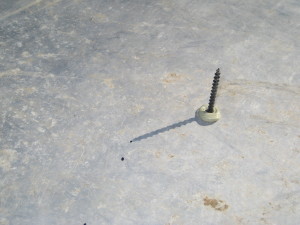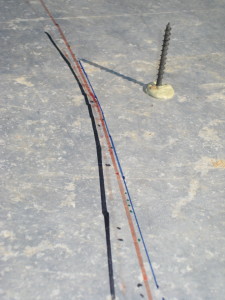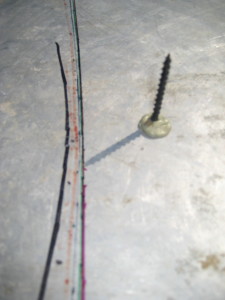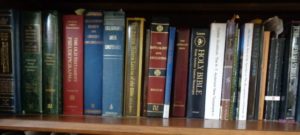Genesis 1:14-15 tells us that Elohim/God put luminaries in the expanse of the heavens to divide between the day and the night, to give light upon the earth and to serve for signs to mark, for seasons, for days and years.
For the past 2-3 weeks, we’ve been tracking the path of the sun to see what we can learn as it relates to being “for signs to mark, for seasons, for days and years”.
We made a raised, level rectangular metal table with the short ends facing north and south. We attached a screw (about 1-1/4″) on its head near the southern end of the table. I’ve been marking the tip of the shadow throughout various clear sunny days, and connecting the dots for days with enough data to show a path from mid-morning to late afternoon. (We have trees along the eastern and western horizons here, so it’s hard to map the early morning and late evening “hours”.)
 We chose to construct it this way (without attempting to take into consideration our latitude) because we are only interested in noting patterns in the sun’s path and learn from them. We are using a metal surface: the downside is that it is reflective, the upside is its durability. I would recommend a light colored surface to make it easier to see the contrast of the shadow.
We chose to construct it this way (without attempting to take into consideration our latitude) because we are only interested in noting patterns in the sun’s path and learn from them. We are using a metal surface: the downside is that it is reflective, the upside is its durability. I would recommend a light colored surface to make it easier to see the contrast of the shadow.
Based on my observation there have been arcs of shadow with the center of the arc in the southern region and the extremities in the northern region. Each day these arcs have been flattening as the shadows move southward.
The above photo on the left shows a broad black line recording the sun’s path on 2/27/14. The broad (dark) red line represents 3/8/14, and the fine blue line represents 3/11/14. The photo on the right was taken several days later and shows a fine green line that was done on 3/13/14. The brown line was done on 3/14/14, and the magenta line (partial) was done on 3/15. This is just an up close depiction of the mid-day.
As you can see these arcs get very close and even overlap some in the middle. It is my understanding that the shortest distance between the arcs and the screw is the north/south intersection. (Once we have a straight line, I will mark the north/south and east/west lines on the table.)
Below is a photo of a straight edge lining up the two ends of the completed magenta line from 3/15. While the arcs appear to be getting flatter, it is still not quite straight.
 We had cloudy weather yesterday and today, so I was unable to capture the sun’s path these days.
We had cloudy weather yesterday and today, so I was unable to capture the sun’s path these days.
The tips of the shadows in the morning and evening are harder to see than at mid-day, so it’s very possible I may be in error with some of my markings. The fact that these markings appear to be symmetrical give me reason to believe they are fairly accurate.
My intention in recording these things is primarily to learn for myself through observation what the sun is doing in relation to my position on the earth. I’m not trying to make predictions or even teach others what to do or look at. I’m simply sharing what I’m doing and my observations along the way.
The Book of Enoch records the rising and setting of the sun in certain “portals” in the east and west for increments of 30 days, 30 days and 31 days that repeat four times in the year, with the 31st day being a day where the day and night are of equal length (9:9), the day is longest in the year or the day is shortest. It appears to me, given the time of year it is, that the sun is transitioning from days growing longer to be equal with the night (aka winter) to the length of days growing longer than the nights (aka spring).
My hunch is that when the path of the sun is a straight east-west line, that is the threshold or “31st day”, marking the end of winter and beginning of spring. I intend to continue to mark our sundial over the next several days and weeks ahead. I’m expecting the lines to start arching the other way as they continue to move southward on our table. I’ll share a follow-up to this post as soon as I have something worthwhile to share. 😉




Pingback: Path of the Spring Equinox in Central Virginia | Messyanic Misfits
Pingback: Sun Gives Signs to Mark | Messyanic Misfits
Pingback: Let Them Be…For Seasons | Messyanic Misfits